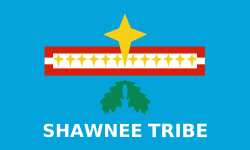Shawnee Tribe facts for kids

Shawnee Tribal flag
|
|
| Total population | |
|---|---|
| 10,000 | |
| Regions with significant populations | |
| Languages | |
| Shawnee, English | |
| Religion | |
| Christianity, Native American Church, traditional tribal religion | |
| Related ethnic groups | |
| other Shawnee tribes and Sac and Fox |
The Shawnee Tribe is a Native American tribe. They are officially recognized by the United States government. This tribe lives in Oklahoma. They were once called the Loyal Shawnee. The Shawnee Tribe is one of three recognized Shawnee groups. The other two are the Absentee-Shawnee Tribe and the Eastern Shawnee Tribe of Oklahoma.
Contents
How the Shawnee Tribe Supports Itself
The Shawnee Tribe has many ways to support its community. They create their own special vehicle tags. They also run a housing authority. This helps tribal members find homes.
The tribe owns several businesses. These include a smoke shop and the Shawnee Trails Gift Shop and Gallery. They also have a company called Shawnee Development LLC. This company helps the tribe grow its economy. Experts believe the tribe adds about $3 million to the economy each year.
Shawnee Development LLC started in 2001. It is owned by the tribe. But it works separately from the main tribal government. The tribe also publishes a newspaper. It is called The Shawnee Journal. All tribal members get this newspaper for free.
Shawnee Culture and Traditions
The Shawnee people still practice many old traditions. They hold special ceremonies. These include the Spring and Fall Bread Dance. They also celebrate the Green Corn ceremony. Stomp dances are also a big part of their culture. These events usually happen in White Oak, Oklahoma.
Some Shawnee people also take part in Native American Church ceremonies. These often involve peyote. Most of these ceremonies happen in the winter. This is when they are not holding their traditional Shawnee events.
A Look at Shawnee History

The Shawnee Tribe is an Eastern Woodland tribe. They originally lived in Ohio and Pennsylvania. They were the last Shawnee group to leave their old homes there. In the late 1700s, more European-Americans moved onto Shawnee lands. Because of this, one group of Shawnee moved to Missouri. They later became the Absentee Shawnee.
In the early 1800s, a group of Native American tribes came together. This happened in the Great Lakes area of the United States. It was called Tecumseh's confederacy. This group grew over several years. It included thousands of warriors. A Shawnee leader named Tecumseh led them. He worked to unite different tribes. He wanted them to stand against European settlers. These settlers were moving across the Appalachian Mountains onto their land.
Under Tecumseh's leadership, the tribes fought the United States. This happened during Tecumseh's War and the War of 1812. But the group broke apart in 1813. This was after Tecumseh died at the Battle of the Thames.
In 1817, the Shawnee were given three reservations in Ohio. This was part of the Treaty of Fort Meigs. These lands were Wapakoneta, Lewistown, and Hog Creek. After the Indian Removal Act of 1830, another Shawnee group moved. They went to Indian Territory in July 1831. The last group, who became the Shawnee Tribe, moved to Kansas in August 1831. Their lands in Kansas became much smaller in 1854. Then, in 1858, the land was divided into individual plots.
During the Civil War, many Shawnee Tribe members fought for the Union. This is why they were called "Loyal Shawnee." But when they returned to Kansas, they found problems. Many non-Indian settlers had taken over their land. These settlers were given about 130,000 acres (526 square kilometers) of Shawnee land. The tribe kept about 70,000 acres (283 square kilometers). Of that, 20,000 acres (81 square kilometers) went to the Absentee Shawnee.
In 1861, Kansas became a state. People in Kansas wanted all Indian tribes to leave the state. The Loyal Shawnee made an agreement with the Cherokee Nation in 1869. This allowed 722 Shawnee people to become citizens of the Cherokee tribe. They also received plots of Cherokee land. They mostly settled in what is now Craig and Rogers County, Oklahoma. They were known as the "Cherokee Shawnee." They settled in areas like Bird Creek (now Sperry), Hudson Creek (now Fairland), and White Oak. The Shawnee Reservation in Kansas was never officially closed. Some Shawnee families still own their land plots in Kansas.
In the 1980s, the Shawnee Tribe began working to become their own tribe again. They wanted to be separate from the Cherokee Nation. In 2000, Congress passed a law called Public Law 106-568. It was the Shawnee Tribe Status Act. This law allowed the Shawnee Tribe to become an independent, federally recognized tribe. James R. Squirrel was their first Chairman. He was recognized in 2009 for his important role in getting the tribe recognized.
Shawnee Tribe Government
The main office of the Shawnee Tribe is in Miami, Oklahoma. Today, there are about 2,226 members in the tribe. About 1,070 of them live in Oklahoma.
Ben Barnes is the current elected Chief of the tribe. Before him, Ron Sparkman was the elected chairman. He served a four-year term.
Famous Loyal Shawnee People
- Heidi BigKnife, a talented jeweler and silversmith.
- Ruthe Blalock Jones, a painter, printmaker, and art teacher.
- Yvonne Chouteau, a famous ballet dancer.
- Timmy Lee Jr, a Texas Blues Rock guitarist.

